
Rhodostrophia calabra is a moth of the family Geometridae first described by Vincenzo Petagna in 1786. It is found from the Iberian Peninsula and a small isolated population in Morocco, through southern France, the western and southern Alps, Italy, the eastern coast of the Adriatic Sea to the southern parts of the Balkan Peninsula. In central Europe it is only found as an isolated population in central France and Rheinland-Pfalz. It is not found on the islands in the Mediterranean Sea. In the Balkans there is an isolated population in the border region of northern Bulgaria and Serbia. Furthermore, it is present on the eastern shores of the Black Sea in Turkey and in the Caucasus.

Bembecia ichneumoniformis, the six-belted clearwing, is a moth of the family Sesiidae.

Bembecia is a genus of moths in the family Sesiidae.

Sannina uroceriformis, the persimmon borer, is a moth of the family Sesiidae. It is found along the Atlantic coast of the United States, from New Jersey to Florida and westward to Texas, Oklahoma, Missouri, Kansas, Ohio and Indiana.
Bembecia albanensis is a moth of the family Sesiidae. It is found from most of Europe to Asia Minor and the Black Sea. It is also found in North Africa.
Bembecia blanka is a moth of the family Sesiidae. It is found on the Greek island of Crete.

Bembecia flavida is a moth of the family Sesiidae. It is found on Sicily and in North Africa, including Algeria, Morocco and Tunisia.
Bembecia fokidensis is a moth of the family Sesiidae. It is found in Greece.
Bembecia himmighoffeni is a moth of the family Sesiidae. It is found from the Iberian Peninsula, through Italy to the Dalmatian coast.

Bembecia hymenopteriformis is a moth of the family Sesiidae. It is found in Spain, mainland Italy and on Sicily. It is also known from the Maghreb countries in North Africa.
Bembecia lomatiaeformis is a moth of the family Sesiidae. It is found from Greece to Turkey and the Caucasus.

Bembecia megillaeformis is a moth of the family Sesiidae. It is found in central and south-eastern Europe, east to Turkey, Uralsk, the Crimea and the Black Sea.
Bembecia priesneri is a moth of the family Sesiidae. It is found in Turkey and some nearby Dodecanese islands.
Bembecia sanguinolenta is a moth of the family Sesiidae. It is found from Bulgaria and Greece to Asia Minor, Armenia, Syria and Turkmenistan.
Bembecia stiziformis is a moth of the family Sesiidae. It is found on Cyprus and from Turkey to Iran, Turkmenistan and Pakistan.
Bembecia syzcjovi is a moth of the family Sesiidae. It is found in Turkey, Georgia and Iran.

Bembecia scopigera, the six-belted clearwing, is a moth of the family Sesiidae. It is found from central Spain over most of south-western and central Europe, the Balkans, Greece, southern Russia and Ukraine to Turkey.

Pyropteron triannuliformis is a moth of the family Sesiidae. It is found from most of Europe to the Near East and Central Asia.

Bembecia vulcanica is a species of moth in the family Sesiidae. It is found on the Canary Islands.








